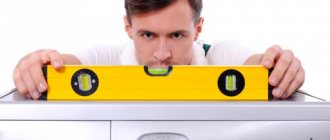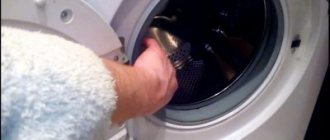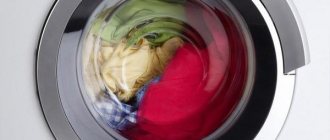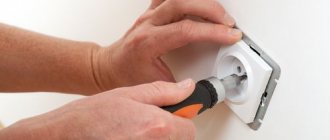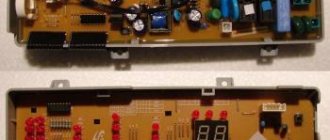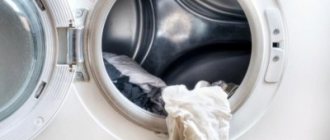Thanks to the efforts of manufacturers, automatic washing machines are highly reliable and owners do not even suspect that the washing machine may someday fail. Therefore, in situations where the washing machine stops during washing, many users do not even know what to do. Calling a technician from the service center will certainly solve the problem, but the workshop is not always nearby, and specialist visits are scheduled almost a month in advance. Therefore, you first need to try to fix the problem yourself, because the machine does not always stop washing due to serious malfunctions. In the event of an unexpected stop of the washing machine, first of all you need to make sure that there is electricity and water, and that there is no blockage in the sewer. Very often, overloading of the machine drum and software failures cause the washing to stop.
If the program on the washing machine has gone wrong. What to do
If everything is in order with the communications, and there is no excess laundry loaded into the drum, you need to check whether the washing machine program has failed. To do this, just “reboot” the washing machine by following a few simple steps:
- unplug the washing machine from the socket;
- wait a few minutes;
- insert the plug back;
- restart the interrupted wash program.
If the reason for the stop was a program failure in the Indesit washing machine or a washing machine of another brand, the machine will start the selected mode and completely complete the washing cycle. In the future, the washing machine will work as before and there is no need to call a technician. Failures most often occur due to voltage changes in the electrical network or changes in pressure in the water supply. But if the machine stopped not because the program on the washing machine went wrong, we’ll look at what to do next in more detail.
Malfunction caused by the user
Most often, the spin cycle in the machine does not work due to the user’s carelessness. The reason may also be a violation of the rules for operating washing equipment.
For example, if the washing mode is selected incorrectly, the laundry pulled out of the drum will be wet or damp. It should be noted that some delicate wash cycles do not spin the laundry. Due to this, it is possible to preserve the delicate fabric.
A clog in the pump or drain filter can cause serious problems with your washing equipment. Such blockages occur due to lack of proper care of the washing machine.
The filter must be cleaned regularly. This way you will prevent clogging of the drain system, which causes water to stagnate and an unpleasant odor to appear. If the equipment does not spin out the laundry and the drum contains water, then first of all you should check the drain filter.
In Samsung washing machines it can be found behind a small door, which is located in the lower right corner of the machine. There is a hose near the filter cover. You can use it to drain the remaining water from the drum. Next, you need to unscrew the drain filter and remove the blockage.
Poor spinning of laundry can also occur when the drum is underloaded or overloaded with laundry. If you load bulky items into the unit, the load on the washing machine parts will increase, and the spin of the laundry will be of poor quality. Also, do not machine wash items that are too light. They will cause imbalance and perform poorly.
What to do if the washing machine stops during washing
Usually, after an emergency stop, an error code appears on the washer display indicating a faulty unit. But sometimes the washing machine freezes, the timer shows the time until the end of the wash, but nothing else happens (the drum does not rotate, the water does not drain or enter the tank, and the timer readings do not change). In such situations, you need to pay attention to the displayed time. When the machine stops at the beginning of the cycle, there may be a malfunction of the water tank filling system, heating element or electric motor. But if the washing process is at the final stage or the washing machine freezes at the last minute, there is probably a problem when performing one of the subroutines: rinsing, draining or spinning.
Troubleshooting
When you sequentially check all the details listed above, you will definitely find an element due to which the Samsung washing machine does not spin out the laundry.
As a rule, to eliminate a malfunction, you need to replace the damaged element. However, if the impeller is damaged, you can only replace it, and not the entire pump.
We suggest you familiarize yourself with How to clean the filter in a washing machine Indesit, Samsung, LG, Bosch
If you cannot find a suitable impeller, you will have to purchase a new pump.
Sometimes it is possible to repair a faulty pressure switch by replacing its electrical part.
So, Samsung washing equipment may not spin for many reasons, ranging from simple user errors to serious malfunctions. In any case, it is better to fix the breakdown immediately.
You may also be interested in reading:
- Samsung washing machine shows error h1 - what to do?
- Samsung washing machine does not spin or drain water - reasons
- How to clean a washing machine drain hose
- How to remove the top cover of a Samsung washing machine
What to do when the washing machine stops rinsing
If the washing machine does not proceed to rinse and spin, you need to determine what is preventing the program from moving to the next washing stage. The operating algorithm of the washing machine provides that before rinsing, the water from the tank is drained and clean water is collected. Therefore, most often the culprit of the stop is problems with drainage, since the tank filling system worked at previous stages of washing or a breakdown in the control board. To make sure that the drain unit is working properly, you need to reset the installed program and enable the drain mode separately (in each model this option is implemented differently and you will find how to do this in your washing machine in the description). If the washing machine freezes and refuses to drain water, you need to check the components of the drainage system:
- drain filter;
- drain pump;
- drain hose;
- internal pipes.
But first you need to disconnect the washing machine from the electricity and water supply and drain the water manually through the emergency drain tube, filter cover or drain hose lowered below the tank level. If water drains normally through the filter, but does not leave through the drain hose, you need to study the information on how to change the drain hose in a washing machine and install a new one yourself. It is also necessary to check the serviceability of the pump. Usually, when working, it makes characteristic sounds. If the pump is silent, check the voltage at its terminals with a tester or multimeter. If it does, the pump needs to be replaced. In cases where the components of the drainage unit are normal, but the washing machine still stops rinsing, there is probably a problem with the control controller and you need to contact a workshop.
Three operating errors leading to no spin
Any housewife will be upset if her favorite washing “assistant” does not spin. Washing laundry by hand, especially if it is heavy and bulky, is not an easy job. But don’t rush to start it!
Spin is the final stage of washing. But it is not provided for by any washing program. Sometimes the spin is performed only partially (at minimum drum speed), sometimes it is not performed at all. In the latter case, the water simply drains from the machine, and the laundry remains very wet.
If, upon opening the hatch door, you find that the laundry is floating in a small amount of water, check the wash program settings. Perhaps it does not involve spinning. Such programs are:
- sensitive,
- delicate,
- careful,
- washing fine linen,
- silk,
- wool, others.
It may be that the “Spin” mode was turned off manually by someone in the household.
To spin the laundry in these cases, simply reset the control panel control to spin mode and start the process by pressing the “Start” button.
We suggest you read How to install a washing machine in the kitchen
If you have selected a program that includes a spin cycle, check two more possible operating errors:
- Washing machine imbalance.
- Exceeding the maximum possible weight load.
Some washing machines report this in case of imbalance or overload by displaying an error code on the display. Other units simply stop working and do not spin the laundry.
Imbalance and overload are dangerous for the washing machine, so, to protect itself and its owner, it stops working without carrying out the most active stage of washing - spinning clothes at high drum speeds.
Imbalance - a violation of the distribution of laundry in the drum of the washing machine (clumped into a lump or loaded in a stack).
To eliminate the imbalance, just open the machine and distribute the laundry evenly.
Overloading with weight is even easier to eliminate. Some of the loaded laundry is removed from the machine.
So, remove some of the laundry or redistribute it in the washing machine and try spinning.
If the washing machine is stuck on the spin cycle, what should you do?
First of all, check your wash settings. In some modes, spinning is either not provided at all or is turned on manually after a long soaking (rinsing). Start the cycle manually and wait until the wash finishes.
One of the frequent failures during the operation of washing machines is the situation when the washing machine freezes at one time each time, and this time period corresponds to the beginning of the spin cycle. This may be caused by:
- insufficient or excessive loading of the drum with laundry;
- loading one too heavy or bulky item;
- jamming of the drum with a foreign object.
If the washing machine stops during washing for these reasons, it will not be difficult for an experienced owner to fix them without calling a service center specialist.
Why did the problem occur?
In automatic washing machines, after starting the wash, many processes occur. First, water is drawn into the tank and the powder is washed away from the prewash cell. Next, the drum of the machine begins to spin slowly. This is how the pre-wash is carried out.
Then the dirty water is drained and clean water is collected again. This water flushes the detergent from the main wash compartment. When the main wash process is completed, the waste water is drained again and clean water is collected. The laundry rinsing process starts.
After rinsing, the machine drains the waste contaminated water. Next, the spin cycle starts. And at this stage problems may arise.
The machine does not spin the drum, and after a short period of time it completely freezes. At best, the machine will display a system error. Then the owners will be able to find out about the malfunction. But sometimes the device does not produce any errors.
First you need to check the simplest reasons that have no connection with technical faults.
Such reasons are usually associated with the fact that the owner of the machine performed incorrect actions.
Such reasons include:
- the drum is overloaded with laundry;
- an item that is too bulky or heavy is loaded;
- The drum of the machine is not loaded enough;
- another washing program was selected (by mistake);
- a foreign object entering the tank jams the drum. As a result, the latter cannot accelerate to high speeds.
When the machine is overloaded, the laundry clumps into a lump and an imbalance in the drum occurs. During the spin cycle, the drum begins to rotate at high speeds and the laundry, knocked into a ball, can damage the drive mechanism. To prevent this malfunction, the machine stops the program immediately. To perform a spin cycle, you need to properly load the drum with laundry.
The situation is much worse when a foreign object gets stuck in the tank. It may jam the drum or damage the tank. In the second case, water will flow out of the machine. Therefore, a stuck object must be pulled out immediately.
If it was not possible to find and eliminate the cause of the freeze at this stage, then you can move on to technical faults. Here, to find and fix the breakdown, you will most likely have to disassemble the machine.
You should not repair the device yourself if you are not sure that you can handle it. In this case, it is better to entrust the repair work to a specialist. Then save time and money.
The washing machine froze during the spin cycle. Major breakdowns
In addition to the reasons that are most often attributed to user errors, failure of the washing machine components can also lead to situations where the washing machine freezes on the spin cycle. It can be:
- a failed pressure switch (water level sensor), which does not confirm the absence of water in the tank and the control board does not issue a command to move to the next step of the washing program (spin).
- malfunction of the balance sensor (not installed on all models);
- wear of the damper or shock absorber of the washing machine, which leads to increased vibration and activation of the protection;
- stretched drive belt;
- bearing corrosion (the drum cannot reach the required speed);
- breakdown of the tachometer that controls the speed of the electric motor. The control board has no information about the armature rotation speed and stops washing;
- problems with drainage (described in the previous section);
- malfunction of control board elements.
Usually, the above-described malfunctions are eliminated by service center specialists, since disassembling the washing machine and skills in working with equipment are required.
If you find an error, please select a piece of text and press Ctrl+Enter.
Troubleshooting
What to do if your Samsung washing machine does not spin clothes? Spinning may not occur if technical problems occur. To find out the cause of the breakdown, you need to perform a sequence of actions.
It is advisable to check the machine parts in the following order:
- Water pump;
- Tacho sensor;
- Electric motor;
- Pressostat;
- Control module.
So, the check needs to start with the pump, tachometer and electric motor.
To do this you need:
- Shut off the water supply.
- Disconnect the machine from the water supply and sewer system.
- Remove the device from the place in which it is installed.
- Remove the powder receptacle.
- Carefully place the machine on its left side. This will prevent water from leaking onto the electrical elements of the washing machine.
- Remove the pallet. This work must be done carefully. The leakage sensor wire should remain undamaged.
- Next you need to find the pipe that goes from the machine tank to the pump. Remove the plastic clamps securing this pipe.
- Remove the pipe and check its condition. It should not contain dirt or other objects.
- The pump is held in place with screws. You need to unscrew them and then remove the pump itself.
- Check the condition of the pump. There should be no damage to it. You also need to carefully inspect the impeller.
We measure the resistance at the contacts of the dismantled pump. This is done using a multimeter. A three-digit number will appear on the device screen if the pump is working.
Next you need to check the tachometer. It is a small device. Externally, the tachometer looks like a ring from which wires stick out.
This part is located on the electric motor. Its purpose is to transmit data on the intensity of rotation of moving engine parts to the control module. Spinning laundry without this part is impossible.
We invite you to familiarize yourself with the weight of laundry for a washing machine: table for calculation
First you need to disconnect the tachometer wires. Next, you need to remove the sensor itself from the washing machine motor. Using a multimeter, we check the resistance and determine the serviceability of the part.
Next you need to disconnect the wires from the motor. You need to work carefully. Then remove the drive belt from the pulley.
It is recommended to take a photo of the wiring location on the motor. This will greatly simplify the subsequent installation of the engine in its original place.
Next, you need to unscrew the fasteners securing the electric motor, and then carefully pull it out. First of all, you need to remove and check the condition of the brushes, since they very often fail.
Use a multimeter to check the winding resistance. If the winding is broken, the motor most likely cannot be restored. Of course, you can give it to a master who will rewind it. However, such repairs will cost almost the same as a new engine. It's easier to buy a new motor.
The next step is to check the pressure switch. If this sensor malfunctions, the machine will not be able to spin the laundry. After all, the control module does not receive information about the water level in the tank and freezes until the laundry starts spinning.
To get to this sensor, you will have to remove the top cover. Under the lid there is a plastic washer with a tube. This is a pressure switch. You need to disconnect the wiring from the sensor and carefully remove it. The main part of the pressure switch is made of plastic. However, it also contains an electrical part. You need to check it with a multimeter. You also need to blow out the pressure switch tube.
Reasons for freezing
We list the factors that may cause the washing machine to freeze:
- The heating element may break;
- the hose or filter is clogged;
- the drain pump is broken;
- a mode is set that does not involve draining water or spinning clothes;
- too many things for one download;
- unit overload.
One of the reasons for freezing of the washing machine is a breakdown of the heating element. This malfunction is evidenced by the freezing of household appliances at the very beginning of operation. You can notice that the heating element has stopped heating the water. In this case, it is recommended to contact a service center.
If freezing occurs during rinsing or spinning, the hoses located inside or outside may be clogged, or the filters may be clogged. Often in such cases the drain pump breaks.
If a mode is mistakenly selected that does not involve draining the water or spinning the laundry, the machine stops while rinsing.
Read more about washing modes in this article.
If the washing machine is overloaded, it should stop based on a signal from the weight sensor. This will happen at the start of work. To do this, you simply need to reduce the amount of laundry for one wash.
Drive mechanism failure
Bearing failure is one of the most common failures. It occurs on machines that are very worn out. When a bearing fails, the drum of the machine produces the sound of grinding metal as it rotates.
It should be noted that replacing a bearing is a very labor-intensive task. If there is no rumble and the bearings are in good condition, but the spinning of the laundry does not start, then you need to carefully listen to the noise the machine makes just before it freezes.
If the washer makes a slight whistle and there is a sharp drop in the rotation speed of the drum, then you need to check the condition of the drive belt.
A stretched drive belt slides along the pulley when the drum rotation speed suddenly increases, resulting in a drop in speed. A stretched belt must be replaced with a new one.
This is done as follows:
- Washing equipment is disconnected from the power supply and communications.
- Pull out the unit to a place where it will be convenient to work with it.
- The back wall of the machine is dismantled.
- Remove the stretched drive belt. To do this, you need to take it with one hand and rotate the drum pulley with the other hand.
- Place a new belt on the electric motor pulley. Next, slowly rotate the drum pulley and put a belt on it. Then you need to make sure that the belt sits well on the pulleys.
- Reassemble the machine in reverse order.
How to fix freezing
First of all, you need to check whether the washer responds to other commands. If not a single button works after pressing, then the unit must be rebooted. To do this, remove the plug from the socket, and after 5 minutes insert it again. If there are no other breakdowns, then it should turn on from the moment the washing machine was stuck on one program.
If the trick did not work and the equipment is still inactive, then you need to reset the previously set mode: press the start button and hold for several seconds. After resetting, turn on the wash again
But when this method does not help, you will have to forcefully drain the water and take out the laundry. You can do this as follows:
- Disconnect the machine from the network.
- Find the drain filter in the lower corner and next to it a hose with a cap.
- Lower it into the basin and remove the cap.
- Drain the water.
If the machine does not have an emergency hose, then the water is removed through a hole with a drain filter.
Other methods: through a drain hose or pipe. When the water has completely drained, the door lock will disengage and you can open it. After this, all that remains is to begin inspection and diagnosis.
Possible faults requiring repair
Unfortunately, if the above advice did not help, you can almost say with one hundred percent certainty that your Samsung is broken. According to the experience of RemBytTech specialists, in machines of this brand, in the absence of a spin cycle, the following components most often fail.
The motor brushes are worn out - from 1,700 rubles.
Graphite brushes are responsible for transmitting voltage from the stator to the rotor. As they shorten, the motor power drops, it is enough for low speeds (during washing), but Samsung can no longer accelerate during the spin cycle.
When the brush carbons become so short that they lose contact with the commutator, the rotation of the drum stops altogether.
Signs
The Samsung washing machine does not spin and may spark. If you continue to use it, after a while the drum stops spinning altogether. Error codes UE, E4, UB or 3E, EA, 3E1, 3E2, 3E3, 3E4 may appear on the display.
How to fix
The brushes need to be replaced with new ones.
The drive belt has stretched, fallen off or broken - from RUB 1,100.
The drive belt transmits rotation from the motor shaft to the drum. If the belt is stretched, the SMA will wash as usual, but will not be able to gain spin speed. If the belt falls off or breaks, there will be no rotation at all.
Signs
The washing machine does not pick up speed during the spin cycle or does not spin the drum at all. Codes UE, E4, UB or 3E, EA, 3E1, 3E2, 3E3, 3E4 may appear on the display.
How to fix
The belt needs to be replaced with a new one. The technician also diagnoses bearings and crosspieces. Often the belt falls off, stretches or breaks due to wear.
Bearings collapsed - from 4000 rubles.
Bearings ensure smooth rotation of the drum. As the machine is used, the seal loses its seal, moisture gets into the bearings, and the corrosion process begins. When the bearings are destroyed, the machine's ability to rotate the drum is reduced, so if you ignore the problem, at some point the drum will completely jam or it will fall down.
Signs
The Samsung washing machine makes a loud noise and vibrates a lot during the spin cycle when it tries to pick up speed, but does not spin. If you remove the back cover of the car, rusty moisture stains will be visible on the tank. Sometimes owners notice that the drum dangles a lot if it is shaken by hand. The display may display codes UE, E4, UB.
How to fix
It is necessary to replace the oil seal and both bearings with new ones.
Faulty control module (electronic controller) - from RUB 2,400.
Probably, individual radio elements of the microcircuit have failed, the tracks/contacts in the motor circuit have burned out, or the firmware has gone wrong.
Most often, the board suffers due to power surges and moisture ingress.
Signs
The Samsung washing machine does not spin or spin the drum at all. A wide variety of error codes may appear on the display.
How to fix
The technician diagnoses the board and, based on the examination results:
- replaces failed radioelements;
- solders suspicious tracks and/or contacts;
- reprograms the memory of the control unit if the firmware is faulty;
- in case of extensive damage to the board (for example, a processor failure), it is replaced with a new one.
The tachometer has failed - from 1900 rubles.
This unit is located on the engine rotor. In good condition, it determines the rotation speed and transmits data to the control board. Often the coil in the tachometer burns out or the magnet becomes unscrewed.
Signs
The Samsung machine does not spin. The code UE, E4, UB is displayed on the screen; 3E, EA, 3E1, 3E2, 3E3, 3E4 or bE (6E), Eb, bE1, bE2, bE3.
How to fix
The technician inspects the tachometer. If a magnet comes loose, it returns it to its place. If the tachometer itself has burned out, replace it with a new one.
Shock absorbers are worn out - from 2600 rubles.
In good condition, shock absorbers dampen vibrations of the SMA. As they wear out, the vibration-suppressing properties decrease, an imbalance occurs, the machine jumps and, therefore, cannot gain momentum.
Signs
SMA Samsung knocks and jumps during the spin cycle, the drum does not pick up speed, and the laundry remains wet.
How to fix
Both shock absorbers need to be replaced.
The pressure switch, which is responsible for determining the water level in the tank, is faulty - from 1900 rubles.
It's probably stuck in the "full tank" position. As a rule, failure of the pressure switch is associated with a clogged pressure chamber, pressure switch hose, or a malfunction of the sensor itself.
Signs
The Samsung washing machine did not spin out the clothes. When I try to start the program again, it doesn’t even draw water. Code 1E (IE), E7, 1C (IC) may appear on the display.
How to fix
The technician diagnoses the pressure switch and, based on the nature of the malfunction:
- cleans the pressure sampling chamber;
- blows out the water level sensor tube;
- Changes the sensor completely.
The electric motor burned out - from 2400 rubles.
The motor drives the drum of the washing machine. The windings probably broke, so the machine no longer turns the drum.
Signs
The Samsung washing machine drained the water but did not spin out the clothes. When starting a new program, the SMA does not spin the drum at all. Error codes bE (6E), Eb, bE1, bE2, bE3 may appear on the display; UE, E4, UB or 3E, EA, 3E1, 3E2, 3E3, 3E4
How to fix
The motor needs to be replaced with a new one.
Faulty wiring or contacts in the motor or tachometer circuit - from RUB 1,800.
The wiring is chafed by vibrations during operation of the washing machine, the contacts move away, oxidize or burn out. In the private sector, wiring and contacts can be damaged by mice or rats.
Signs
The Samsung washing machine drained the water but did not spin out the clothes. When starting a new program, the SMA does not spin the drum at all. Error codes bE (6E), Eb, bE1, bE2, bE3 may appear on the display; UE, E4, UB or 3E, EA, 3E1, 3E2, 3E3, 3E4.
Indirect reasons for stopping the washing machine
After washing and rinsing, did the washing machine freeze or spin the drum several times and stop? Start by eliminating reasons related to the way the machine is controlled. Namely:
- Check the set mode. Perhaps a program without draining and spinning has been selected? This is likely when washing woolen and delicate fabrics. Then just turn on the spin cycle to get things working.
- Make sure the drum is not overloaded with laundry. When things get wet, they become heavier, and rapid rotations can damage the drive mechanism. Therefore, the machine stops working. It is enough to open the hatch and take out some of the things.
- Are you sure that the reason is not an imbalance? This happens when one large thing is downloaded. The drum spins, which knocks the laundry into a heavy lump and leads to imbalance. To fix the problem, distribute the items evenly in the drum.
Such errors in handling equipment lead to the stoppage of all automatic washing machines that are equipped with electronic controls. These may be models from manufacturers Samsung, LG, Indesit and other brands.

